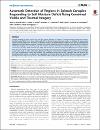Automatic detection of regions in spinach canopies responding to soil moisture deficit using combined visible and thermal imagery

View/
Date
2014-06Author
Raza, Shan-E.-AhmedSmith, Hazel K.
Clarkson, Graham J.J.
Taylor, Gail
Thompson, Andrew J.
Clarkson, John
Rajpoot, Nasir M.
...show more authors ...show less authors
Metadata
Show full item recordAbstract
Thermal imaging has been used in the past for remote detection of regions of canopy showing symptoms of stress, including water deficit stress. Stress indices derived from thermal images have been used as an indicator of canopy water status, but these depend on the choice of reference surfaces and environmental conditions and can be confounded by variations in complex canopy structure. Therefore, in this work, instead of using stress indices, information from thermal and visible light imagery was combined along with machine learning techniques to identify regions of canopy showing a response to soil water deficit. Thermal and visible light images of a spinach canopy with different levels of soil moisture were captured. Statistical measurements from these images were extracted and used to classify between canopies growing in well-watered soil or under soil moisture deficit using Support Vector Machines (SVM) and Gaussian Processes Classifier (GPC) and a combination of both the classifiers. The classification results show a high correlation with soil moisture. We demonstrate that regions of a spinach crop responding to soil water deficit can be identified by using machine learning techniques with a high accuracy of 97%. This method could, in principle, be applied to any crop at a range of scales.
Collections
- Computer Science & Engineering [2485 items ]

